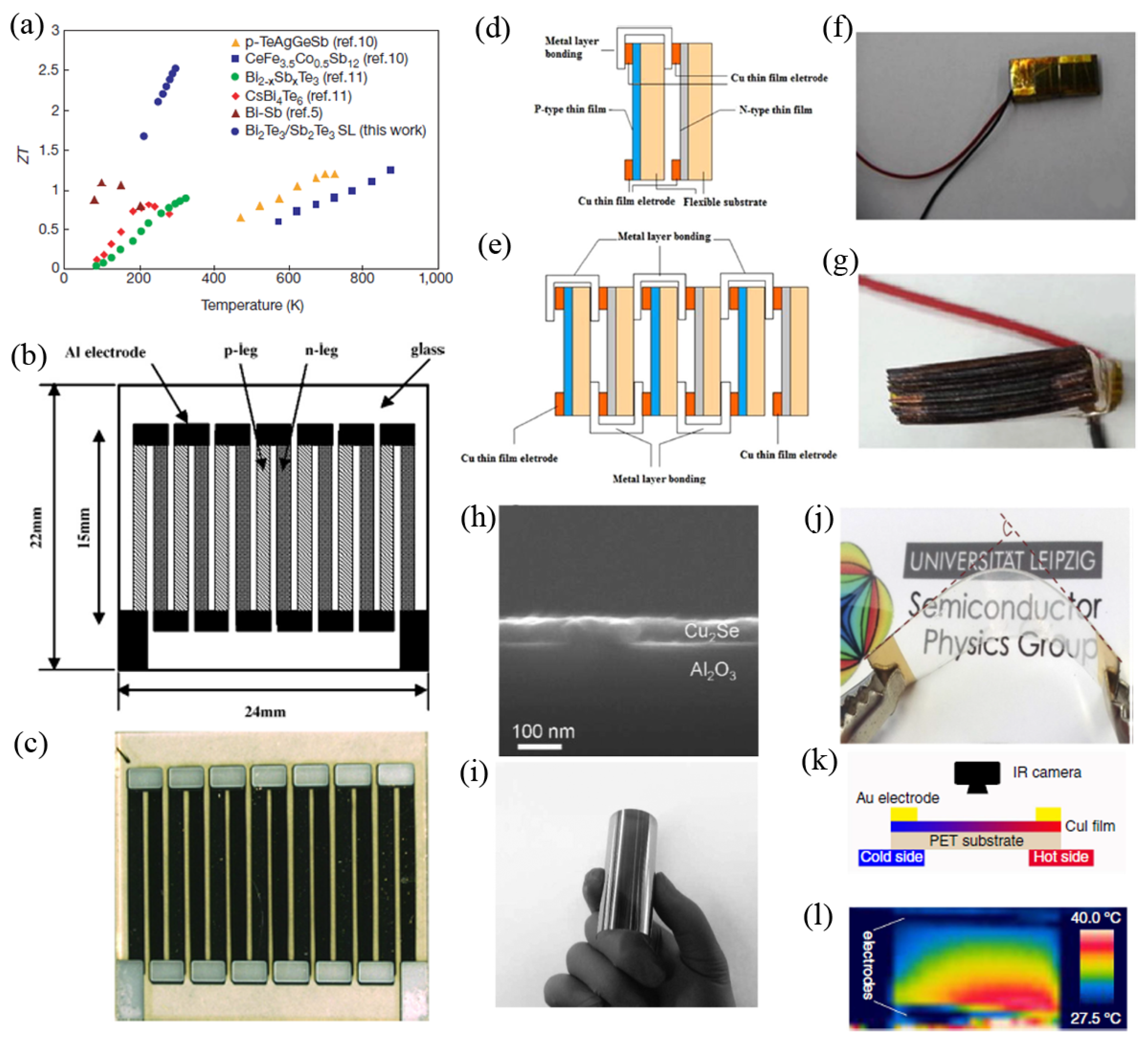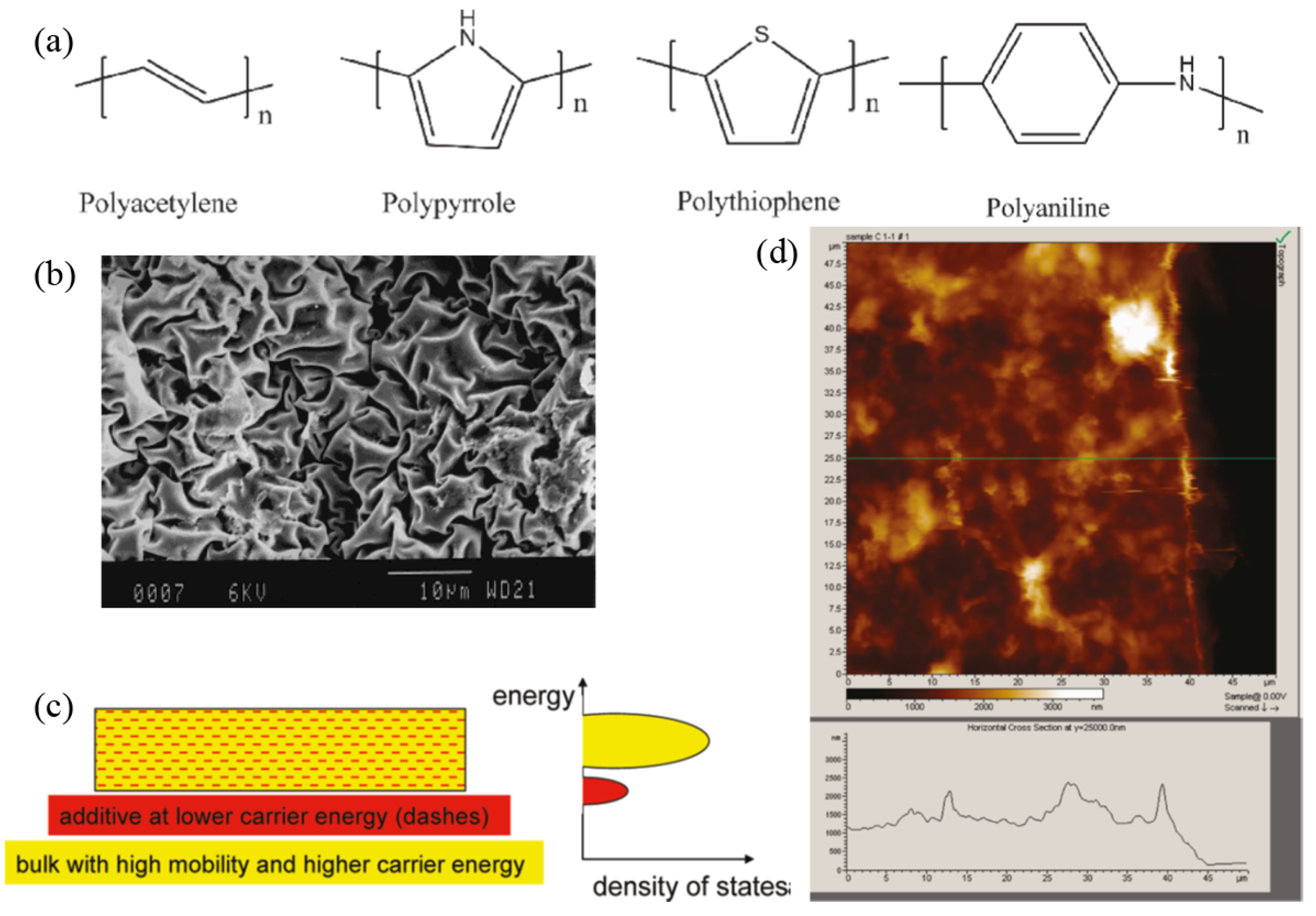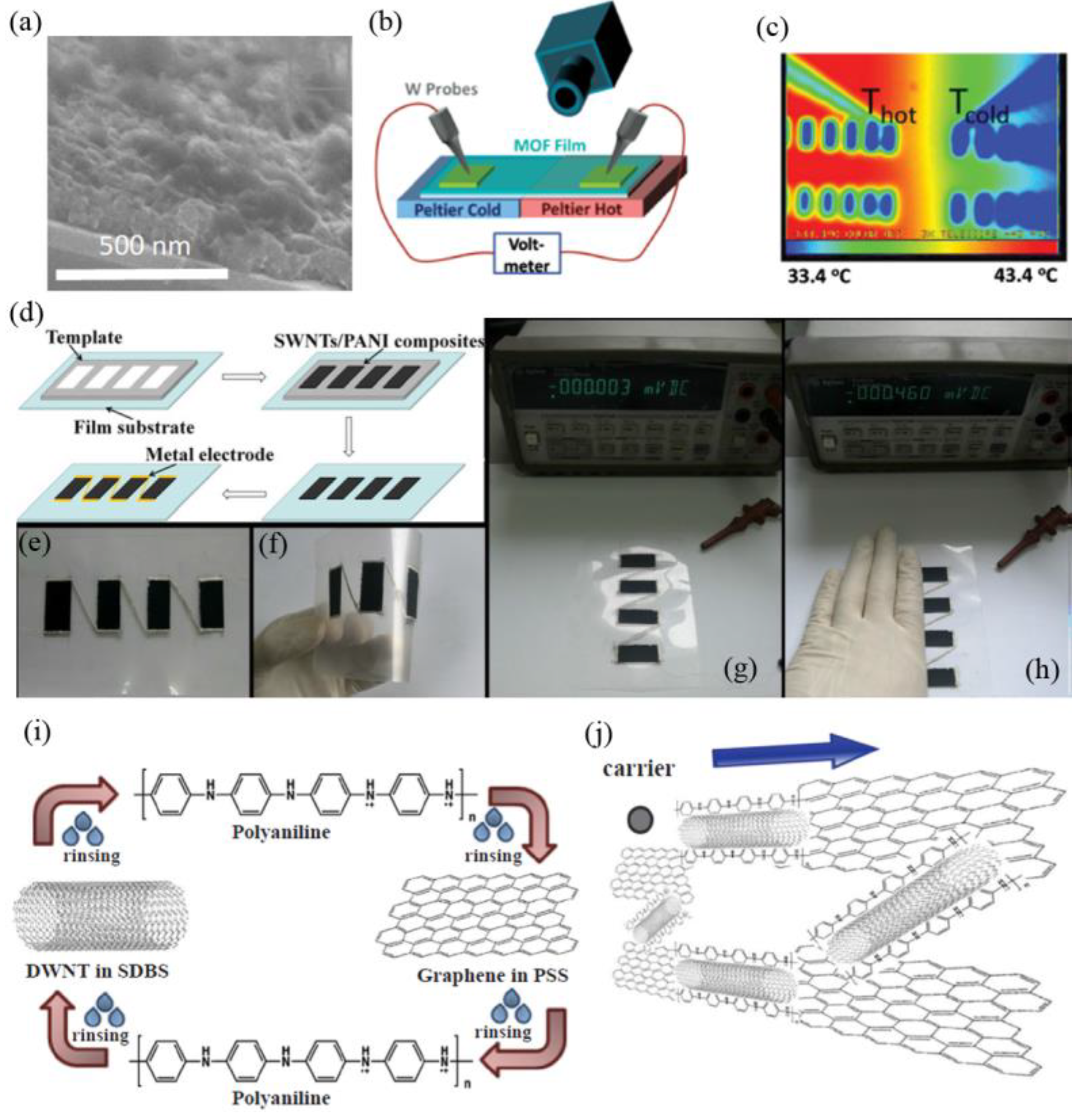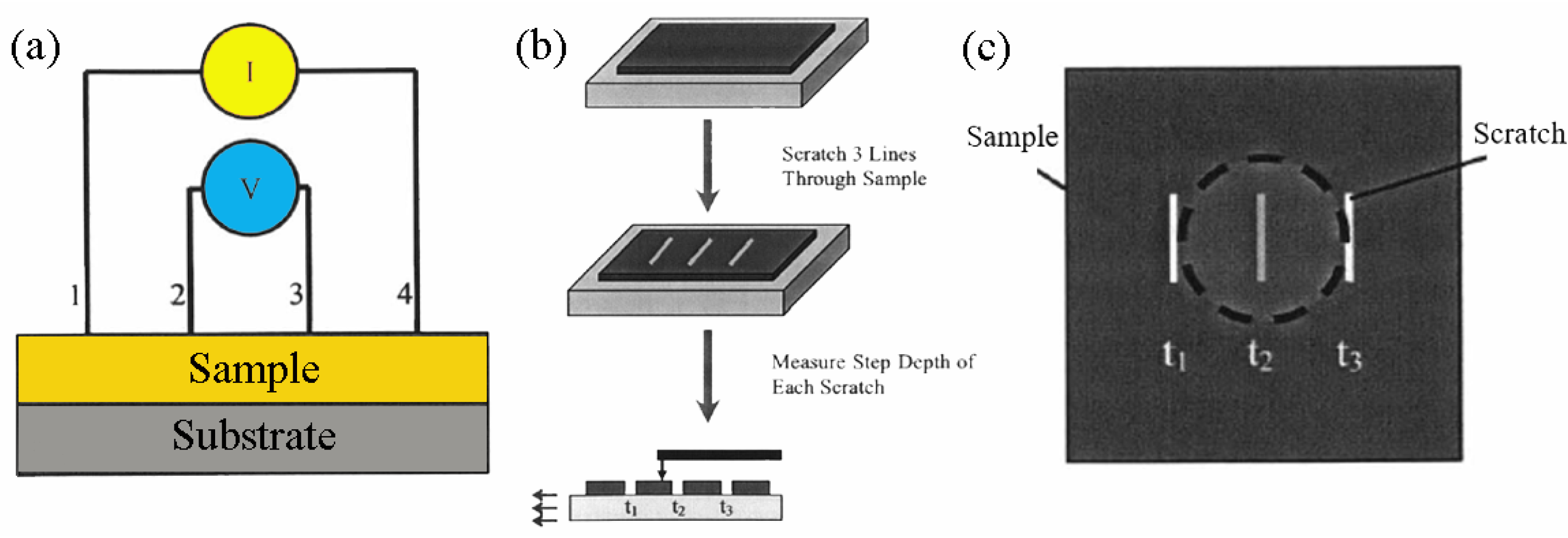Thin Film Thermoelectric Materials: Classification, Characterization, and Potential for Wearable Applications
Abstract
1. Introduction
2. Classification of Thin-Film TE Materials
2.1. Inorganic-Based Thin Film TE Materials
2.1.1. Bi-Te Based Superlattices
2.1.2. Zn Based Thin Films
2.1.3. Cu Based Thin Films
2.1.4. Cobalt Oxide-Based Thin Films
2.2. Organic-Based Thin Film TE Materials
2.2.1. Polyacetylene and Polyaniline
2.2.2. Polypyrrole and Polythiophene
2.2.3. Poly(3,4-ethylenedioxythiophene)
2.2.4. Other n-type Polymers
2.3. Inorganic-Organic Composite Thin Film TE Materials
2.3.1. Metal-Organic Frameworks
2.3.2. Carbon Nanotube-Polymer Composites
3. Measurement Technique of Thin Film TE Materials
3.1. Electrical Conductivity
3.2. Seebeck Coefficient
3.3. Thermal Conductivity
4. Conclusions and Outlooks
Funding
Conflicts of Interest
References
- Service, R.F. Temperature rises for devices that turn heat into electricity. Science 2004, 306, 806–807. [Google Scholar] [CrossRef] [PubMed]
- Lan, Y.; Minnich, A.J.; Chen, G.; Ren, Z. Enhancement of thermoelectric figure-of-merit by a bulk nanostructuring approach. Adv. Funct. Mater. 2010, 20, 357–376. [Google Scholar] [CrossRef]
- Nielsch, K.; Bachmann, J.; Kimling, J.; Böttner, H. Thermoelectric nanostructures: From physical model systems towards nanograined composites. Adv. Energy Mater. 2011, 1, 713–731. [Google Scholar] [CrossRef]
- Yang, J.; Shen, D.; Zhou, L.; Li, W.; Li, X.; Yao, C.; Wang, R.; El-Toni, A.M.; Zhang, F.; Zhao, D. Spatially confined fabrication of core-shell gold nanocages@mesoporous silica for near-infrared controlled photothermal drug release. Chem. Mater. 2013, 25, 3030–3037. [Google Scholar] [CrossRef]
- Yang, J.; Wang, Y.; Chou, S.; Zhang, R.; Xu, Y.; Fan, J.; Zhang, W.; Liu, H.; Zhao, D.; Dou, S. Yolk-shell silicon-mesoporous carbon anode with compact solid electrolyte interphase film for superior lithium-ion batteries. Nano Energy 2015, 18, 133–142. [Google Scholar] [CrossRef]
- Yang, J.; Wang, Y.; Li, W.; Wang, L.; Fan, Y.; Jiang, W.; Luo, W.; Wang, Y.; Kong, B.; Selomulya, C.; et al. Amorphous TiO2 shells: A vital elastic buffering layer on silicon nanoparticles for high-performance and safe lithium storage. Adv. Mater. 2017, 29, 1700523. [Google Scholar] [CrossRef] [PubMed]
- Wang, Q.; Zhao, Y.; Luo, W.; Jiang, W.; Fan, J.; Wang, L.; Jiang, W.; Zhang, W.; Yang, J. Iron nanoparticles in capsules: Derived from mesoporous silica-protected prussian blue microcubes as efficient selenium removal. Chem. Commum. 2018, 46, 5887–5890. [Google Scholar] [CrossRef] [PubMed]
- Minnich, A.J.; Dresselhaus, M.S.; Ren, Z.; Chen, G. Bulk nanostructured thermoelectric materials: Current research and future prospects. Energy Environ. Sci. 2009, 2, 466–479. [Google Scholar] [CrossRef]
- Snyder, G.J.; Toberer, E.S. Complex thermoelectric materials. Nat. Mater. 2008, 7, 105–114. [Google Scholar] [CrossRef] [PubMed]
- Bell, L.E. Cooling, heating, generating power, and recovering waste heat with thermoelectric systems. Science 2008, 321, 1457–1461. [Google Scholar] [CrossRef] [PubMed]
- Wu, Y.; Finefrock, S.W.; Yang, H. Nanostructured thermoelectric: Opportunities and challenges. Nano Energy 2012, 1, 651–653. [Google Scholar] [CrossRef]
- Vineis, C.J.; Shakouri, A.; Majumdar, A.; Kanatzidis, M.G. Nanostructured thermoelectrics: Big efficiency gains from small features. Adv. Mater. 2010, 22, 3970–3980. [Google Scholar] [CrossRef] [PubMed]
- Zhang, G.; Yu, Q.; Wang, W.; Li, X. Nanostructures for thermoelectric applications: Synthesis, growth mechanism, and property studies. Adv. Mater. 2010, 22, 1959–1962. [Google Scholar] [CrossRef] [PubMed]
- Seebeck, T.J. Ueber die magnetische polarisation der metalle and erze durch temperatur-differenz. Ann. Phys. 1821, 82, 133–160. (In Germany) [Google Scholar] [CrossRef]
- Qiu, P.; Shi, X.; Chen, L. Cu-based thermoelectric materials. Energy Storage Mater. 2016, 3, 85–97. [Google Scholar] [CrossRef]
- Dennler, G.; Chmielowski, R.; Jacob, S.; Capet, F.; Roussel, P.; Zastrow, S.; Nielsch, K.; Opahle, I.; Madsen, G.K.H. Are binary copper sulfides/selenides really new and promising thermoelectric materials? Adv. Energy Mater. 2014, 4, 1301581. [Google Scholar] [CrossRef]
- Han, C.; Sun, Q.; Li, Z.; Dou, S. Thermoelectric enhancement of different kinds of metal chalcogenides. Adv. Energy Mater. 2016, 6, 1600498. [Google Scholar] [CrossRef]
- Böttner, H.; Chen, G.; Venkatasubramanian, R. Aspects of thin-film superlattice thermoelectric materials, devices, and applications. MRS Bull. 2006, 31, 211–217. [Google Scholar] [CrossRef]
- Harman, T.C.; Taylor, P.J.; Walsh, M.P.; LaForge, B.E. Quantum dot superlattice thermoelectric materials and devices. Science 2002, 297, 2229–2232. [Google Scholar] [CrossRef] [PubMed]
- Zhao, W.; Liu, Z.; Sun, Z.; Zhang, Q.; Wei, P.; Mu, X.; Zhou, H.; Li, C.; Ma, S.; He, D.; et al. Superparamagnetic enhancement of thermoelectric performance. Nature 2017, 549, 247–251. [Google Scholar] [CrossRef] [PubMed]
- Chen, X.; Li, Z.; Dou, S. Ambient facile synthesis of gram-scale copper selenide nanostructures from commercial copper and selenium powder. ACS Appl. Mater. Interfaces 2015, 7, 13295–13302. [Google Scholar] [CrossRef] [PubMed]
- Chen, X.; Li, Z.; Yang, J.; Sun, Q.; Dou, S. Aqueous preparation of surfactant-free copper selenide nanowires. J. Colloid Interface Sci. 2015, 442, 140–146. [Google Scholar] [CrossRef] [PubMed]
- Zhang, L.; Chen, X.; Han, C. Application prospects of thermoelectric technique. Res. Dev. Mater. Sci. 2018, 3, 000571. [Google Scholar]
- Chen, Z.; Shi, X.; Zhao, L.; Zou, J. High-performance SnSe thermoelectric materials: Progress and future challenge. Prog. Mater. Sci. 2018, 97, 283–346. [Google Scholar] [CrossRef]
- Zhou, W.; Fan, Q.; Zhang, Q.; Cai, L.; Li, K.; Gu, X.; Yang, F.; Zhang, N.; Wang, Y.; Liu, H.; et al. High-performance and compact-designed flexible thermoelectric modules enabled by a reticulate carbon nanotube architecture. Nat. Commun. 2017, 8, 14886. [Google Scholar] [CrossRef] [PubMed]
- Bubnova, O.; Khan, Z.U.; Malti, A.; Braun, S.; Fahlman, M.; Berggren, M.; Crispin, X. Optimization of the thermoelectric figure of merit in the conducting polymer poly(3,4-ethylenedioxythiophene). Nat. Mater. 2011, 10, 429–433. [Google Scholar] [CrossRef] [PubMed]
- Lin, Z.; Hollar, C.; Kang, J.; Yin, A.; Wang, Y.; Shiu, H.; Huang, Y.; Hu, Y.; Zhang, Y.; Duan, X. A solution processable high-performance thermoelectric copper selenide thin film. Adv. Mater. 2017, 29, 1606662. [Google Scholar] [CrossRef] [PubMed]
- Yang, C.; Souchay, D.; Kneiss, M.; Bogner, M.; Wei, H.; Lorenz, M.; Oeckler, O.; Benstetter, G.; Fu, Y.; Grundmann, M. Transparent flexible thermoelectric material based on non-toxic earth-abundant p-type copper iodide thin film. Nat. Commun. 2017, 8, 16076. [Google Scholar] [CrossRef] [PubMed]
- Dresselhaus, M.S.; Chen, G.; Tang, M.; Yang, R.; Lee, H.; Wang, D.; Ren, Z.; Fleurial, J.P.; Gogna, P. New directions for low-dimensional thermoelectric materials. Adv. Mater. 2007, 19, 1043–1053. [Google Scholar] [CrossRef]
- Zhang, Q.; Ai, X.; Wang, L.; Chang, Y.; Luo, W.; Jiang, W.; Chen, L. Improved thermoelectric performance of silver nanoparticles-dispersed Bi2Te3 composites deriving from hierarchical two-phased heterostructure. Adv. Funct. Mater. 2015, 25, 966–976. [Google Scholar] [CrossRef]
- Venkatasubramanian, R.; Siivola, E.; Colpitts, T.; O’Quinn, B. Thin-film thermoelectric devices with high room-temperature figures of merit. Nature 2001, 413, 597–602. [Google Scholar] [CrossRef] [PubMed]
- Takashiri, M.; Shirakawa, T.; Miyazaki, K.; Tsukamoto, H. Fabrication and characterization of bismuth-telluride-based alloy thin film thermoelectric generators by flash evaporation method. Sens. Actuators A-Phys. 2007, 138, 329–334. [Google Scholar] [CrossRef]
- Venkatasubramanian, R.; Colpitts, T.; O’Quinn, B.; Liu, S.; El-Masry, N.; Lamvik, M. Low-temperature organometallic epitaxy and its application to superlattice structures in thermoelectrics. Appl. Phys. Lett. 1999, 75, 1104–1106. [Google Scholar] [CrossRef]
- Fan, P.; Li, Y.; Zheng, Z.; Lin, Q.; Luo, J.; Liang, G.; Zhang, M.; Chen, M. Thermoelectric properties optimization of al-doped ZnO thin films prepared by reactive sputtering Zn-Al alloy target. Appl. Surf. Sci. 2013, 284, 145–149. [Google Scholar] [CrossRef]
- Fan, P.; Zheng, Z.; Li, Y.; Lin, Q.; Luo, J.; Liang, G.; Cai, X.; Zhang, D.; Ye, F. Low-cost flexible thin film thermoelectric generator on zinc based thermoelectric materials. Appl. Phys. Lett. 2015, 106, 073901. [Google Scholar] [CrossRef]
- Teranishi, T.; Mori, Y.; Hayashi, H.; Kishimoto, A. Thermoelectric property of polycrystalline aluminum-doped zinc oxide enhanced by micropore foaming. J. Am. Ceram. Soc. 2012, 95, 690–695. [Google Scholar] [CrossRef]
- Ghosh, C.K.; Das, S.; Chattopadhyay, K.K. Enhancement of thermopower of Mn doped ZnO thin film. Phys. B Condens. Matter 2007, 399, 38–46. [Google Scholar] [CrossRef]
- Loureiro, J.; Neves, N.; Barros, R.; Mateus, T.; Santos, R.; Filonovich, S.; Reparaz, S.; Sotomayor-Torres, C.M.; Wyczisk, F.; Divay, L.; et al. Transparent aluminium zinc oxide thin films with enhanced thermoelectric properties. J. Mater. Chem. A 2014, 2, 6649–6655. [Google Scholar] [CrossRef]
- Chen, X.; Bai, Y.; Li, Z.; Wang, L.; Dou, S. Ambient synthesis of one-/two-dimensional CuAgSe ternary nanotubes as counter electrodes of quantum-dot-sensitized solar cells. ChemPlusChem 2016, 81, 414–420. [Google Scholar] [CrossRef]
- Chen, X.; Li, Z.; Bai, Y.; Sun, Q.; Wang, L.; Dou, S. Room-temperature synthesis of Cu2−xE (E = S, Se) nanotubes with hierarchical architecture as high-performance counter electrodes of quantum-dot-sensitized solar cells. Chem. Eur. J. 2015, 21, 1055–1063. [Google Scholar] [CrossRef] [PubMed]
- Tan, M.; Chen, X. Growth mechanism of single crystal nanowires of fcc metals (Ag, Cu, Ni) and hcp metal (Co) electrodeposited. J. Electrochem. Soc. 2012, 159, K15–K20. [Google Scholar] [CrossRef]
- Nunna, R.; Qiu, P.; Yin, M.; Chen, H.; Hanus, R.; Song, Q.; Zhang, T.; Chou, M.; Agne, M.T.; He, J.; et al. Ultrahigh thermoelectric performance in Cu2Se-based hybrid materials with highly dispersed molecular CNTs. Energy Environ. Sci. 2017, 10, 1928–1935. [Google Scholar] [CrossRef]
- Yang, C.; Kneiβ, M.; Lorenz, M.; Grundmann, M. Room-temperature synthesized copper iodide thin film as degenerate p-type transparent conductor with a boosted figure of merit. Proc. Natl. Acad. Sci. 2016, 113, 12929–12933. [Google Scholar] [CrossRef] [PubMed]
- Ohta, H. Thermoelectrics Based on Metal Oxide Thin Films. In Metal Oxide-Based Thin Film Structures: Formation, Characterization and Application of Interface-Based Phenomena, A Volume in Metal Oxides; Pryds, N., Esposito, V., Eds.; Elsevier: Amsterdam, The Netherlands, 2018; pp. 441–464. [Google Scholar]
- Ravichandran, J. Thermoelectric and thermal transport properties of complex oxide thin films, heterostructures and superlattices. J. Mater. Res. 2016, 32, 183–203. [Google Scholar] [CrossRef]
- Terasaki, I.; Sasago, Y.; Uchinokura, K. Large thermoelectric power in NaCo2O4 single crystals. Phys. Rev. B 1997, 56, 685–687. [Google Scholar] [CrossRef]
- Masset, A.C.; Michel, C.; Maignan, A.; Hervieu, M.; Toulemonde, O.; Studer, F.; Raveau, B. Misfit-layered cobaltite with an anisotropic giant magnetorsistance Ca3Co4O9. Phys. Rev. B 2000, 62, 166–175. [Google Scholar] [CrossRef]
- Paul, B.; Lu, J.; Eklund, P. Nanostructural tailoring to induce flexibility in thermoelectric Ca3Co4O9 thin films. ACS Appl. Mater. Interfaces 2017, 9, 25308–25316. [Google Scholar] [CrossRef] [PubMed]
- Paul, B.; Bjork, E.M.; Kumar, A.; Lu, J.; Eklund, P. Nanoporous Ca3Co4O9 thin films for transferable thermoelectrics. ACS Appl. Energy Mater. 2018, 1, 2261–2268. [Google Scholar] [CrossRef] [PubMed]
- Gushing, B.L.; Falster, A.U.; Simmons, W.B.; Wiley, J.B. A multivalent ion exchange route to lamellar calcium cobalt oxides CaxCoO2 (x ≤ 0.5). Chem. Commun. 1996, 23, 2635–2636. [Google Scholar] [CrossRef]
- Liu, J.; Huang, X.; Xu, G.; Chen, L. Thermoelectric properties of layered Sr0.29CoO2 crystals. J. Alloy. Compd. 2013, 576, 247–249. [Google Scholar] [CrossRef]
- Liu, J.; Huang, X.; Li, F.; Liu, R.; Chen, L. Low-temperature magnetic and thermoelectric properties of layered Ca0.33CoO2 crystals. J. Phys. Soc. Jpn. 2011, 80, 074802. [Google Scholar] [CrossRef]
- Liu, W.; Kim, H.; Jie, Q.; Ren, Z. Importance of high power factor in thermoelectric materials for power generation application a perspective. Scr. Mater. 2016, 111, 3–9. [Google Scholar] [CrossRef]
- Lévesque, I.; Bertrand, P.O.; Blouin, N.; Leclerc, M.; Zecchin, S.; Zotti, G.; Ratcliffe, C.I.; Klug, D.D.; Gao, X.; Gao, F.; et al. Synthesis and thermoelectric properties of polycarbazole, polyindolocarbazole, and polydiindolocarbazole derivatives. Chem. Mater. 2007, 19, 2128–2138. [Google Scholar] [CrossRef]
- Kim, G.H.; Shao, L.; Zhang, K.; Pipe, K.P. Engineered doping of organic semiconductors for enhanced thermoelectric efficiency. Nat. Mater. 2013, 12, 719–723. [Google Scholar] [CrossRef] [PubMed]
- Bubnova, O.; Khan, Z.U.; Wang, H.; Braun, S.; Evans, D.R.; Fabretto, M.; Hojati-Talemi, P.; Dagnelund, D.; Arlin, J.B.; Geerts, Y.H.; et al. Semi-metallic polymers. Nat. Mater. 2014, 13, 190–194. [Google Scholar] [CrossRef] [PubMed]
- Kolasinska, E.; Kolasinski, P. A review on electroactive polymers for waste heat recovery. Materials 2016, 9, 485. [Google Scholar] [CrossRef] [PubMed]
- Bubnova, O.; Crispin, X. Towards polymer-based organic thermoelectric generators. Energy Environ. Sci. 2012, 5, 9345–9362. [Google Scholar] [CrossRef]
- Shi, K.; Zhang, F.; Di, C.; Yan, T.; Zou, Y.; Zhou, X.; Zhu, D.; Wang, J.; Pei, J. Toward high performance n-type thermoelectric materials by rational modification of BDPPV backbones. J. Am. Chem. Soc. 2015, 137, 6979–6982. [Google Scholar] [CrossRef] [PubMed]
- Dubey, N.; Leclerc, M. Conducting polymers: Efficient thermoelectric materials. J. Polym. Sci. Polym. Phys. 2011, 49, 467–475. [Google Scholar] [CrossRef]
- Zhang, Q.; Sun, Y.; Xu, W.; Zhu, D. Organic thermoelectric materials: Emerging green energy materials converting heat to electricity directly and efficiently. Adv. Mater. 2014, 26, 6829–6851. [Google Scholar] [CrossRef] [PubMed]
- Sun, Y.; Qiu, L.; Tang, L.; Geng, H.; Wang, H.; Zhang, F.; Huang, D.; Xu, W.; Yue, P.; Guan, Y.; et al. Flexible n-type high-performance thermoelectric thin films of poly(nickel-ethylenetetrathiolate) prepared by an electrochemical method. Adv. Mater. 2016, 28, 3351–3358. [Google Scholar] [CrossRef] [PubMed]
- Xuan, Y.; Liu, X.; Desbief, S.; Leclère, P.; Fahlman, M.; Lazzaroni, R.; Berggren, M.; Cornil, J.; Emin, D.; Crispin, X. Thermoelectric properties of conducting polymers: The case of poly(3-hexylthiophene). Phys. Rev. B 2010, 82, 115454. [Google Scholar] [CrossRef]
- Zuzok, R.; Kaiser, A.B.; Pukacki, W.; Roth, S. Thermoelectric power and conductivity of iodine-doped ‘‘new’’ polyacetylene. J. Chem. Phys. 1991, 95, 1270–1275. [Google Scholar] [CrossRef]
- Park, Y.W.; Yoon, C.O.; Na, B.C.; Shirakawa, H.; Akagi, K. Metallic properties of transition metal halides doped polyacetylene: The soliton liquid state. Synth. Met. 1991, 41, 27–32. [Google Scholar] [CrossRef]
- Guo, C.; Chu, F.; Chen, P.; Zhu, J.; Wang, H.; Wang, L.; Fan, Y.; Jiang, W. Effectively enhanced thermopower in polyaniline/Bi0.5Sb1.5Te3 nanoplate composites via carrier energy scattering. J. Mater. Sci. 2018, 53, 6752–6762. [Google Scholar] [CrossRef]
- Li, J.; Tang, X.; Li, H.; Yan, Y.; Zhang, Q. Synthesis and thermoelectric properties of hydrochloric acid-doped polyaniline. Synth. Met. 2010, 160, 1153–1158. [Google Scholar] [CrossRef]
- Sun, Y.; Wei, Z.; Xu, W.; Zhu, D. A three-in-one improvement in thermoelectric properties of polyaniline brought by nanostructures. Synth. Met. 2010, 160, 2371–2376. [Google Scholar] [CrossRef]
- Holland, E.R.; Pomfret, S.J.; Adams, P.N.; Abell, L.; Monkman, A.P. Doping dependent transport properties of polyaniline-CSA films. Synth. Met. 1997, 84, 777–778. [Google Scholar] [CrossRef]
- Tlshima, N. Conductive polymers as a new type of thermoelectric material. Macromol. Symp. 2002, 186, 81–86. [Google Scholar] [CrossRef]
- Kemp, N.T.; Kaiser, A.B.; Liu, C.; Chapman, B.; Mercier, O.; Carr, A.M.; Trodahl, H.J.; Buckley, R.G.; Partridge, A.C.; Lee, J.; et al. Thermoelectric power and conductivity of different types of polypyrrole. J. Polym. Sci. Part B Polym. Phys. 1999, 37, 953–960. [Google Scholar] [CrossRef]
- Lu, B.; Liu, C.; Lu, S.; Xu, J.; Jiang, F.; Li, Y.; Zhang, Z. Thermoelectric performances of free-standing polythiophene and poly(3-methylthiophene) nanofilms. Chin. Phys. Lett. 2010, 27, 057201. [Google Scholar]
- Sun, J.; Yeh, M.L.; Jung, B.J.; Zhang, B.; Feser, J.; Majumdar, A.; Katz, H.E. Simultaneous increase in Seebeck coefficient and conductivity in a doped poly(alkylthiophene) blend with defined density of states. Macromolecules 2010, 43, 2897–2903. [Google Scholar] [CrossRef]
- Liu, J.; Wang, X.; Li, D.; Coates, N.E.; Segalman, R.A.; Cahill, D.G. Thermal conductivity and elastic constants of PEDOT:PSS with high electrical conductivity. Macromolecules 2015, 48, 585–591. [Google Scholar] [CrossRef]
- Luo, J.; Billep, D.; Waechtler, T.; Otto, T.; Toader, M.; Gordan, O.; Sheremet, E.; Martin, J.; Hietschold, M.; Zahn, D.R.T.; et al. Enhancement of the thermoelectric properties of PEDOT:PSS thin films by post-treatment. J. Mater. Chem. A 2013, 1, 7576–7583. [Google Scholar] [CrossRef]
- Bae, E.J.; Kang, Y.H.; Jang, K.S.; Cho, S.Y. Enhancement of thermoelectric properties of PEDOT:PSS and tellurium-PEDOT:PSS hybrid composites by simple chemical treatment. Sci. Rep. 2016, 6, 18805. [Google Scholar] [PubMed]
- Di, C.A.; Xu, W.; Zhu, D.B. Organic thermoelectrics for green energy. Natl. Sci. Rev. 2016, 3, 269–271. [Google Scholar] [CrossRef]
- Sun, Y.; Zhang, J.; Liu, L.; Qin, Y.; Sun, Y.; Xu, W.; Zhu, D. Optimization of the thermoelectric properties of poly(nickel-ethylenetetrathiolate) synthesized via potentiostatic deposition. Sci. China Chem. 2016, 59, 1323–1329. [Google Scholar] [CrossRef]
- Babel, A.; Jenekhe, S.A. High electron mobility in ladder polymer field-effect transistors. J. Am. Chem. Soc. 2003, 125, 13656–13657. [Google Scholar] [CrossRef] [PubMed]
- Wang, S.; Sun, H.; Ail, U.; Vagin, M.; Persson, P.O.A.; Andreasen, J.W.; Thiel, W.; Berggren, M.; Crispin, X.; Fazzi, D.; et al. Thermoelectric properties of solution-processed n-doped ladder-type conducting polymers. Adv. Mater. 2016, 28, 10764–10771. [Google Scholar] [CrossRef] [PubMed]
- Russ, B.; Robb, M.J.; Brunetti, F.G.; Miller, P.L.; Perry, E.E.; Patel, S.N.; Ho, V.; Chang, W.B.; Urban, J.J.; Chabinyc, M.L.; et al. Power factor enhancement in solution-processed organic n-type thermoelectrics through molecular design. Adv. Mater. 2014, 26, 3473–3477. [Google Scholar] [CrossRef] [PubMed]
- Du, Y.; Shen, S.Z.; Cai, K.F.; Casey, P.S. Research progress on polymer–inorganic thermoelectric nanocomposite materials. Prog. Polym. Sci. 2012, 37, 820–841. [Google Scholar] [CrossRef]
- Wan, C.; Gu, X.; Dang, F.; Itoh, T.; Wang, Y.; Sasaki, H.; Kondo, M.; Koga, K.; Yabuki, K.; Snyder, G.J.; et al. Flexible n-type thermoelectric materials by organic intercalation of layered transition metal dichalcogenide TiS2. Nat. Mater. 2015, 14, 622–627. [Google Scholar] [CrossRef] [PubMed]
- Sun, L.; Miyakai, T.; Seki, S.; Dincă, M. Mn2(2,5-disulfhydrylbenzene-1,4-dicarboxylate): A microporous metal-organic framework with infinite (−Mn–S−)∞ chains and high intrinsic charge mobility. J. Am. Chem. Soc. 2013, 135, 8185–8188. [Google Scholar] [CrossRef] [PubMed]
- Sheberla, D.; Sun, L.; Blood-Forsythe, M.A.; Er, S.; Wade, C.R.; Brozek, C.K.; Aspuru-Guzik, A.; Dinca, M. High electrical conductivity in Ni3(2,3,6,7,10,11-hexaiminotriphenylene)2, a semiconducting metal-organic graphene analogue. J. Am. Chem. Soc. 2014, 136, 8859–8862. [Google Scholar] [CrossRef] [PubMed]
- Erickson, K.J.; Leonard, F.; Stavila, V.; Foster, M.E.; Spataru, C.D.; Jones, R.E.; Foley, B.M.; Hopkins, P.E.; Allendorf, M.D.; Talin, A.A. Thin film thermoelectric metal-organic framework with high Seebeck coefficient and low thermal conductivity. Adv. Mater. 2015, 27, 3453–3459. [Google Scholar] [CrossRef] [PubMed]
- Wang, L.; Yao, Q.; Xiao, J.; Zeng, K.; Qu, S.; Shi, W.; Wang, Q.; Chen, L. Engineered molecular chain ordering in single-walled carbon nanotubes/polyaniline composite films for high-performance organic thermoelectric materials. Chem. Asian J. 2016, 11, 1804–1810. [Google Scholar] [CrossRef] [PubMed]
- Cho, C.Y.; Stevens, B.; Hsu, J.H.; Bureau, R.; Hagen, D.A.; Regev, O.; Yu, C.H.; Grunlan, J.C. Completely organic multilayer thin film with thermoelectric power factor rivaling inorganic tellurides. Adv. Mater. 2015, 27, 2996–3001. [Google Scholar] [CrossRef] [PubMed]
- Meng, C.; Liu, C.; Fan, S. A promising approach to enhanced thermoelectric properties using carbon nanotube networks. Adv. Mater. 2010, 22, 535–539. [Google Scholar] [CrossRef] [PubMed]
- Yao, Q.; Chen, L.; Zhang, W.; Liufu, S.C.; Chen, X. Enhanced thermoelectric performance of single-walled carbon nanotubes/polyaniline hybrid nanocomposites. ACS Nano 2010, 4, 2445–2451. [Google Scholar] [CrossRef] [PubMed]
- Luo, W.; Chen, X.; Xia, Y.; Chen, M.; Wang, L.; Wang, Q.; Li, W.; Yang, J. Surface and interface engineering of silicon-based anode materials for lithium-ion batteries. Adv. Energy Mater. 2017, 7, 1701083. [Google Scholar] [CrossRef]
- Luo, W.; Shen, D.; Zhang, R.; Zhang, B.; Wang, Y.; Dou, S.; Liu, H.; Yang, J. Germanium nanograin decoration on carbon shell: Boosting lithium-storage properties of silicon nanoparticles. Adv. Funct. Mater. 2016, 26, 7800–7806. [Google Scholar] [CrossRef]
- Luo, W.; Wang, Y.; Chou, S.; Xu, Y.; Li, W.; Kong, B.; Dou, S.; Liu, H.; Yang, J. Critical thickness of phenolic resin-based carbon interfacial layer for improving long cycling stability of silicon nanoparticle anodes. Nano Energy 2016, 27, 255–264. [Google Scholar] [CrossRef]
- Luo, W.; Wang, Y.; Wang, L.; Jiang, W.; Chou, S.; Dou, S.; Liu, H.; Yang, J. Silicon/mesoporous carbon/crystalline TiO2 nanoparticles for highly stable lithium storage. ACS Nano 2016, 10, 10524–10532. [Google Scholar] [CrossRef] [PubMed]
- Harman, T.C. Special techniques for measurement of thermoelectric properties. J. Appl. Phys. 1958, 29, 1373–1374. [Google Scholar] [CrossRef]
- Singh, R.; Bian, Z.X.; Shakouri, A.; Zeng, G.H.; Bahk, J.H.; Bowers, J.E.; Zide, J.M.O.; Gossard, A.C. Direct measurement of thin-film thermoelectric figure of merit. Appl. Phys. Lett. 2009, 94, 212508. [Google Scholar] [CrossRef]
- Suarez, F.; Parekh, D.P.; Ladd, C.; Vashaee, D.; Dickey, M.D.; Öztürk, M.C. Flexible thermoelectric generator using bulk legs and liquid metal interconnects for wearable electronics. Appl. Energy 2017, 202, 736–745. [Google Scholar] [CrossRef]
- Jia, H.; Tao, X.; Wang, Y. Flexible and self-healing thermoelectric converters based on thermosensitive liquids at low temperature gradient. Adv. Electron. Mater. 2016, 2, 1600136. [Google Scholar] [CrossRef]
- Kuryak, C.A. Nanostructured Thin Film Thermoelectric Composite Materials Using Conductive Polymer PEDOT:PSS. Master’s Thesis, Massachusetts Institute of Technology, Cambridge, MA, USA, April 2013. [Google Scholar]
- Iwanaga, S.; Snyder, G.J. Scanning Seebeck coefficient measurement system for homogeneity characterization of bulk and thin-film thermoelectric materials. J. Electron. Mater. 2012, 41, 1667–1674. [Google Scholar] [CrossRef]
- Wang, H.; Porter, W.D.; Böttner, H.; König, J.; Chen, L.D.; Bai, S.Q.; Tritt, T.M.; Mayolet, A.; Senawiratne, J.; Smith, C.; et al. Transport properties of bulk thermoelectrics—An international round-robin study. Part I: Seebeck coefficient and electrical resistivity. J. Electron. Mater. 2013, 42, 654–664. [Google Scholar] [CrossRef]
- Taylor, P.J.; Maddux, J.R.; Uppal, P.N. Measurement of thermal conductivity using steady-state isothermal conditions and validation by comparison with thermoelectric device performance. J. Electron. Mater. 2012, 41, 2307–2312. [Google Scholar] [CrossRef]
- Taylor, P.J.; Wilson, A.; Maddux, J.R.; Borca-Tasciuc, T.; Moran, S.P.; Castillo, E.; Borca-Tasciuc, D. Novel measurement methods for thermoelectric power generator materials and devices. In Thermoelectrics for Power Generation—A Look at Trends in the Technology; Skipidarov, S., Nikitin, M., Eds.; INTECH: London, UK, 2016; pp. 389–434. [Google Scholar]
- Lu, L.; Yi, W.; Zhang, D. 3ω method for specific heat and thermal conductivity measurements. Rev. Sci. Instrum. 2001, 72, 2996–3003. [Google Scholar] [CrossRef]






© 2018 by the authors. Licensee MDPI, Basel, Switzerland. This article is an open access article distributed under the terms and conditions of the Creative Commons Attribution (CC BY) license (http://creativecommons.org/licenses/by/4.0/).
Share and Cite
Chen, X.; Dai, W.; Wu, T.; Luo, W.; Yang, J.; Jiang, W.; Wang, L. Thin Film Thermoelectric Materials: Classification, Characterization, and Potential for Wearable Applications. Coatings 2018, 8, 244. https://doi.org/10.3390/coatings8070244
Chen X, Dai W, Wu T, Luo W, Yang J, Jiang W, Wang L. Thin Film Thermoelectric Materials: Classification, Characterization, and Potential for Wearable Applications. Coatings. 2018; 8(7):244. https://doi.org/10.3390/coatings8070244
Chicago/Turabian StyleChen, Xinqi, Wei Dai, Tian Wu, Wei Luo, Jianping Yang, Wan Jiang, and Lianjun Wang. 2018. "Thin Film Thermoelectric Materials: Classification, Characterization, and Potential for Wearable Applications" Coatings 8, no. 7: 244. https://doi.org/10.3390/coatings8070244
APA StyleChen, X., Dai, W., Wu, T., Luo, W., Yang, J., Jiang, W., & Wang, L. (2018). Thin Film Thermoelectric Materials: Classification, Characterization, and Potential for Wearable Applications. Coatings, 8(7), 244. https://doi.org/10.3390/coatings8070244




